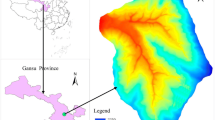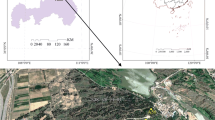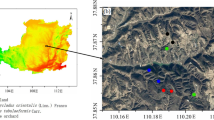Abstract
Knowledge about the effects of vegetation types on soil properties and on water dynamics in the soil profile is critical for revegetation strategies in water-scarce regions, especially the choice of vegetation type and human management measures. We focused on the analysis of the effects of vegetation type on soil hydrological properties and soil moisture variation in the 0–400 cm soil layer based on a long-term (2004―2016) experimental data in the northern Loess Plateau region, China. Soil bulk density (BD), saturated soil hydraulic conductivity (Ks), field capacity (FC) and soil organic carbon (SOC) in 2016, as well as the volumetric soil moisture content during 2004–2016, were measured in four vegetation types, i.e., shrubland (korshinsk peashrub), artificial grassland (alfalfa), fallow land and cropland (millet or potato). Compared with cropland, revegetation with peashrub and alfalfa significantly decreased BD and increased Ks, FC, and SOC in the 0–40 cm soil layer, and fallow land significantly increased FC and SOC in the 0–10 cm soil layer. Soil water storage (SWS) significantly declined in shrubland and grassland in the 40–400 cm soil layer, causing severe soil drought in the deep soil layers. The study suggested that converting cropland to grassland (alfalfa) and shrubland (peashrub) improved soil-hydrological properties, but worsened water conditions in the deep soil profile. However, natural restoration did not intensify deep-soil drying. The results imply that natural restoration could be better than revegetation with peashrub and alfalfa in terms of good soil hydrological processes in the semi-arid Loess Plateau region.
Similar content being viewed by others
References
Cao S X, Chen L, Yu X X. 2009. Impact of China's Grain for Green Project on the landscape of vulnerable arid and semi-arid agricultural regions: a case study in northern Shaanxi Province. Journal of Applied Ecology, 46(3): 536–543.
Cao S X, Chen L, Shankman D, et al. 2011. Excessive reliance on afforestation in China's arid and semi-arid regions: Lessons in ecological restoration. Earth-Science Reviews, 104(4): 240–245.
Chen H S, Shao M A, Li Y Y. 2008. Soil desiccation in the Loess Plateau of China. Geoderma, 143(1–2): 91–100.
Deng L, Liu G B, Shangguan Z P. 2014. Land-use conversion and changing soil carbon stocks in China’s ‘Grain-for-Green’ Program: a synthesis. Global Change Biology, 20(11): 3544–3556.
Deng L, Yan W M, Zhang Y W, et al. 2016. Severe depletion of soil moisture following land-use changes for ecological restoration: evidence from northern China. Forest Ecology and Management, 366: 1–10.
Deng L, Liu S G, Kim D G, et al. 2017. Past and future carbon sequestration benefits of China's grain for green program. Global Environmental Change, 47: 13–20.
Fang X N, Zhao W W, Wang L X, et al. 2016. Variations of deep soil moisture under different vegetation types and influencing factors in a watershed of the Loess Plateau, China. Hydrology and Earth System Sciences, 20(8): 3309–3323.
Fu W, Huang M B, Gallichand J, et al. 2012. Optimization of plant coverage in relation to water balance in the Loess Plateau of China. Geoderma, 173–174: 134–144.
Fu X L, Shao M A, Wei X R, et al. 2010. Soil organic carbon and total nitrogen as affected by vegetation types in Northern Loess Plateau of China. Geoderma, 155(1–2): 31–35.
Gee G W, Or D. 2002. Particle-size analysis. In: Dane J H, Topp G C. Methods of Soil Analysis. Part 4. Physical Methods. Madison: Soil Science Society of America, 255–289.
Issa O M, Valentin C, Rajot J L, et al. 2011. Runoff generation fostered by physical and biological crusts in semi-arid sandy soils. Geoderma, 167–168: 22–29.
Jia X X, Shao M A, Zhang C C, et al. 2015. Regional temporal persistence of dried soil layer along South-North transect of the Loess Plateau, China. Journal of Hydrology, 528: 152–160.
Jia X X, Shao M A, Zhu Y J, et al. 2017. Soil moisture decline due to afforestation across the Loess Plateau, China. Journal of Hydrology, 546: 113–122.
Jia Y H, Shao M A. 2014. Dynamics of deep soil moisture in response to vegetational restoration on the Loess Plateau of China. Journal of Hydrology, 519: 523–531.
Jin T T, Fu B J, Liu G H, et al. 2011. Hydrologic feasibility of artificial forestation in the semi-arid Loess Plateau of China. Hydrology and Earth System Sciences, 15(8): 2519–2530.
Kanwar R S, Rizvi H A, Ahmed M, et al. 1989. Measurement of field-saturated hydraulic conductivity by using Guelph and Velocity permeameters. Transactions of the ASAE, 32(6): 1885–1890.
Li Y Y, Shao M A. 2006. Change of soil physical properties under long-term natural vegetation restoration in the Loess Plateau of China. Journal of Arid Environments, 64(1): 77–96.
Liu B X, Shao M A. 2016. Response of soil water dynamics to precipitation years under different vegetation types on the northern Loess Plateau, China. Journal of Arid Land, 8(1): 47–59.
Liu Y L, Pan Z H, Zhuang Q L, et al. 2015. Agriculture intensifies soil moisture decline in Northern China. Scientific Reports, 5: 11261.
Malagnoux M. 2007. Arid Land Forests of the World: Global Environmental Perspectives. Rome, Italy: Food and Agriculture Organization of the United Nations (FAO).
Nelson D W, Sommers L E. 1982. Total carbon, organic carbon, and organic matter. In: Page A L, Miller R H, Keeney D R. Methods of Soil Analysis, Part 2. Chemical and Microbial Properties (2nd ed.). Madison: Agronomy Society of America, 539–552.
Scott H D. 2000. Soil Physics: Agricultural and Environmental Applications. Iowa: Iowa State University Press, 350–352.
Seneviratne S I, Corti T, Davin E L, et al. 2010. Investigating soil moisture-climate interactions in a changing climate: a review. Earth-Science Reviews, 99(3–4): 125–161.
Shi H, Shao M A. 2000. Soil and water loss from the Loess Plateau in China. Journal of Arid Environments, 45(1): 9–20.
Wang A H, Lettenmaier D P, Sheffield J. 2011. Soil moisture drought in China, 1950–2006. Journal of Climate, 24(13): 3257–3271.
Wang L, Wang Q J, Wei S P, et al. 2008. Soil desiccation for Loess soils on natural and regrown areas. Forest Ecology and Management, 255(7): 2467–2477.
Wang L, Mu Y, Zhang Q F, et al. 2012. Effects of vegetation restoration on soil physical properties in the wind–water erosion region of the Northern Loess Plateau of China. Clean-Soil Air Water, 40(1): 7–15.
Wang Y Q, Shao M A, Liu Z P, et al. 2012. Regional spatial pattern of deep soil water content and its influencing factors. Hydrological Sciences Journal, 57(2): 265–281.
Wu G L, Liu Y, Fang N F, et al. 2016. Soil physical properties response to grassland conversion from cropland on the semi-arid area. Ecohydrology, 9(8): 1471–1479.
Wu H B, Guo Z T, Peng C H. 2003. Land use induced changes of organic carbon storage in soils of China. Global Change Biology, 9(3): 305–315.
Wu H S, Chen X M, Ye M B, et al. 2005. Moisture characteristics and their effect factors of main paddy soils in Tai lake region. Journal of Soil and Water Conservation, 19(1): 181–183, 187. (in Chinese)
Yan W M, Deng L, Zhong Y Q W. 2015. The characters of dry soil layer on the Loess Plateau in China and their influencing factors. PLoS ONE, 10(8): e0134902.
Yang L, Wei W, Chen L, et al. 2012. Spatial variations of shallow and deep soil moisture in the semi-arid Loess Plateau, China. Hydrology and Earth System Sciences, 16(9): 3199–3217.
Yang L, Wei W, Chen L D, et al. 2014. Response of temporal variation of soil moisture to vegetation restoration in semi-arid Loess Plateau, China. CATENA, 115: 123–133.
Yimer F, Ledin S, Abdelkadir A. 2007. Changes in soil organic carbon and total nitrogen contents in three adjacent land use types in the Bale Mountains, south-eastern highlands of Ethiopia. Forest Ecology and Management, 242(2–3): 337–342.
Yüksek T. 2009. Effect of visitor activities on surface soil environmental conditions and aboveground herbaceous biomass in Ayder Natural Park. Clean-Soil Air Water, 37(2): 170–175.
Zeng C. 2006. Study on the soil water cycle on slope with different conditions of vegetation covering in water–wind erosion crisscross region. MSc Thesis. Yangling: Northwest A&F University. (in Chinese)
Zeng C, Shao M A, Wang Q J, et al. 2011. Effects of land use on temporal-spatial variability of soil water and soil-water conservation. Acta Agriculturae Scandinavica, Section B—Soil & Plant Science, 61(1): 1–13.
Zhang S L, Lövdahl L, Grip H, et al. 2007. Soil hydraulic properties of two loess soils in China measured by various field-scale and laboratory methods. CATENA, 69(3): 264–273.
Zhang Y W, Shangguan Z P. 2016. The change of soil water storage in three land use types after 10 years on the Loess Plateau. CATENA, 147: 87–95.
Zhang Z H, Li X Y, Jiang Z Y, et al. 2013. Changes in some soil properties induced by re-conversion of cropland into grassland in the semiarid steppe zone of Inner Mongolia, China. Plant and Soil, 373(1–2): 89–106.
Acknowledgements
This research was supported by the National Natural Science Foundation of China (41501233, 41601216, 41390461), the National Key Project for Research and Development (2016YFC0501605), the Youth Innovation Promotion Association of the Chinese Academy of Sciences (2017076) and the Open Research Fund of the State Key Laboratory of Soil Erosion and Dryland Farming on the Loess Plateau (A314021402-1806). The authors are indebted to the editors and reviewers for the constructive comments and suggestions on the article.
Author information
Authors and Affiliations
Corresponding author
Rights and permissions
About this article
Cite this article
Zhang, Q., Jia, X., Zhao, C. et al. Revegetation with artificial plants improves topsoil hydrological properties but intensifies deep-soil drying in northern Loess Plateau, China. J. Arid Land 10, 335–346 (2018). https://doi.org/10.1007/s40333-018-0007-0
Received:
Revised:
Accepted:
Published:
Issue Date:
DOI: https://doi.org/10.1007/s40333-018-0007-0




